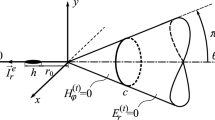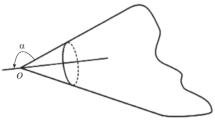We solve the problem of diffraction of the field of radial electric dipole on a cone whose surface is formed by finite perfectly magnetically conducting and truncated semiinfinite perfectly electrically conducting conical surfaces. The problem is solved by the Wiener–Hopf technique with the use of the Kontorovich–Lebedev integral transformation. We obtain the exact solution of the problem in the static limit and its approximate solution in the low-frequency case. We deduce an expression for the directional pattern of a cone with perfectly absorbing vertex (within the framework of the Macdonald model). We also clarify the effect of the edge of absorbing fragment of the cone surface on its scattering properties.
Similar content being viewed by others
References
V. P. Belichenko, G. G. Goshin, A. G. Dmitrienko, et al., Mathematical Methods in Boundary-Value Problems of Electrodynamics [in Russian], Izd. Tomsk. Univ., Tomsk (1990).
E. W. Hobson, The Theory of Spherical and Ellipsoidal Harmonics, Cambridge Univ. Press, Cambridge (1931).
I. S. Gradshteyn and I. M. Ryzhik, Tables of Integrals, Series, and Products, 4th edition, Academic, San Diego (1980).
L. N. Zakhar’ev and A. A. Lemanskii, Wave Scattering by “Black” Bodies [in Russian], Sov. Radio, Moscow (1972).
M. I. Kontorovich and N. N. Lebedev, “On one method for the solution of some problems of the theory of diffraction and related problems,” Zh. Éksp. Teor. Fiz., 8, No. 10-11, 1193–1206 (1938).
B. Noble, Methods Based on the Wiener–Hopf Technique for the Solution of Partial Differential Equations, Pergamon, London (1958).
C. Gokhan, “Wiener–Hopf analysis of plane wave diffraction by an impedance strip attached on a perfectly conducting half-plane,” Electromagnetics, 29, No. 2, 165–184 (2009). Doi:10.1080/02726340802676170.
D. B. Kuryliak and Z. T. Nazarchuk, “Convolution-type operators for wave diffraction by conical structures,” Radio Sci., 43, No. 4, 1–14 (2008). RS4S03, Doi:10.1029/2007RS003792.
H. M. Macdonald, “The diffraction of light by an opaque prism,” Proc. Lond. Math. Soc., s2-12, No. 1, 430–432 (1913). Doi: 10.1112/plms/s2-12.1.430.
J. F. Nye, J. H. Hannay, and W. Liang, “Diffraction by a black half-plane: theory and observation,” Proc. R. Soc. Lond., Ser. A, 449, No. 1937, 515–535 (1995). Doi:10.1098/rspa.1995.0056.
U. Yalcin, “Scattering from perfectly magnetic conducting surfaces: the extended theory of boundary diffraction wave approach,” Prog. Electromagn. Res. M, 7, 123–133 (2009). Doi:10.2528/PIERM09042210.
Author information
Authors and Affiliations
Additional information
Translated from Matematychni Metody ta Fizyko-Mekhanichni Polya, Vol. 56, No. 2, pp. 191–202, April–June, 2013.
Rights and permissions
About this article
Cite this article
Kurylyak, D.B. Diffraction of Electric Waves on a Cone Formed of Perfectly Magnetically and Electrically Conducting Surfaces. J Math Sci 203, 239–252 (2014). https://doi.org/10.1007/s10958-014-2104-8
Received:
Published:
Issue Date:
DOI: https://doi.org/10.1007/s10958-014-2104-8




